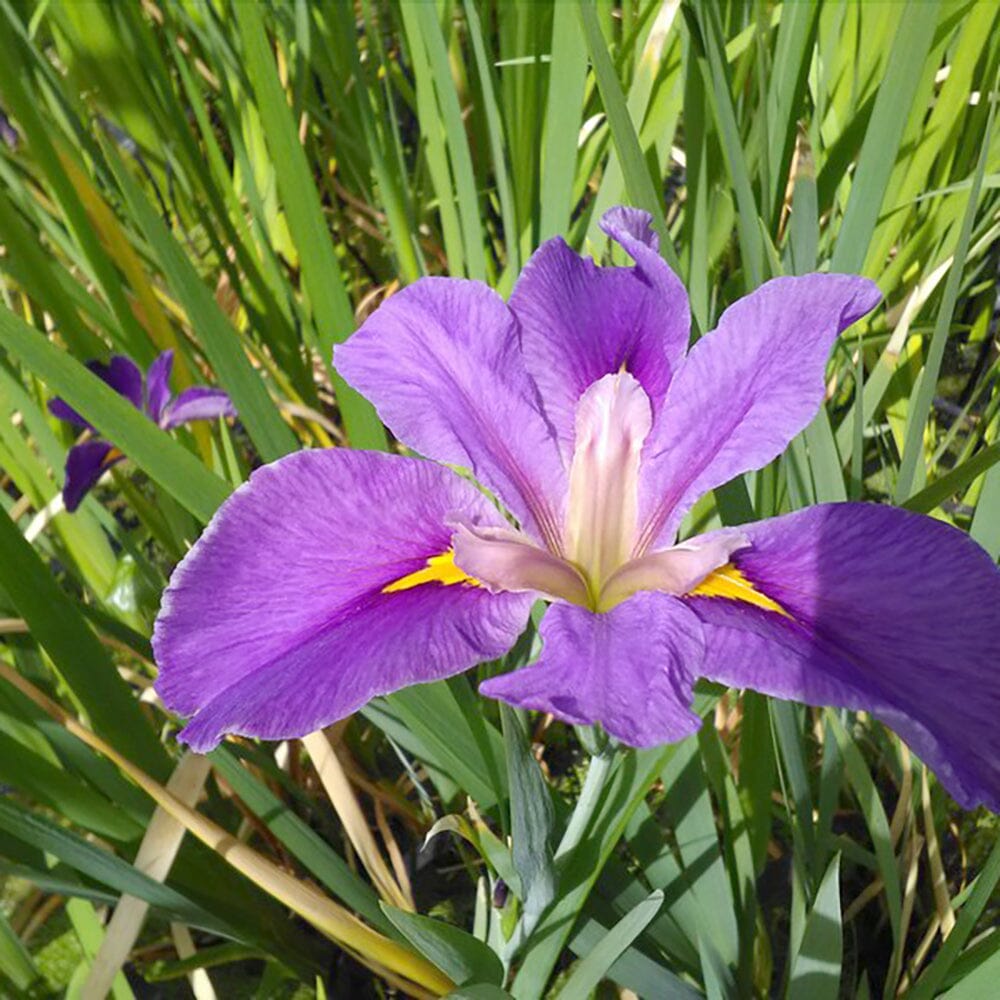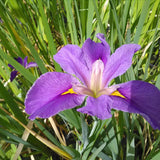Iris Louisiana Pegaletta Aquatic Pond Plant - Louisiana Iris
Iris louisiana 'Pegaletta' is a captivating perennial iris cultivar that belongs to the Iris louisiana species. It is known for its unique and eye-catching flower coloration. 'Pegaletta' typically grows to a height of about 2-3 feet (60-90 cm) and forms clumps of long, upright, sword-shaped leaves. The leaves are deep green in color and provide an attractive backdrop to the flowers. In late spring to early summer, 'Pegaletta' produces large, showy flowers atop tall stems. The flowers are characterized by their striking color combination of lavender-pink petals with a bright orange-red blaze in the center. Each flower has three upright petals called standards and three drooping petals called falls.
Care Guide:
Light Requirements: Iris louisiana 'Pegaletta' thrives in full sun to partial shade. It performs best when exposed to at least 6 hours of direct sunlight each day. However, it can tolerate some shade, particularly in hot climates or during the hottest part of the day.
Soil Requirements: 'Pegaletta' prefers moist, acidic to slightly alkaline soil. It grows well in loamy or clay soils that are rich in organic matter. Ensure that the soil is well-draining to prevent waterlogging, as excessive moisture can lead to root rot.
Watering: This iris cultivar requires regular watering to maintain moist soil conditions. Water deeply but infrequently, allowing the soil to dry slightly between waterings. During hot and dry periods, increase the frequency of watering to keep the soil consistently moist.
Fertilization: 'Pegaletta' benefits from a balanced, slow-release fertilizer applied in early spring or after flowering. Follow the package instructions for the appropriate dosage and apply the fertilizer evenly around the plant, avoiding direct contact with the foliage.
Mulching: Applying a layer of organic mulch around the base of the plant helps conserve soil moisture, suppress weed growth, and maintain a more consistent soil temperature. Apply mulch in early spring, keeping it away from the plant's crown to prevent rotting.
Division: Over time, clumps of Iris louisiana 'Pegaletta' may become crowded, affecting their flowering performance. Dividing the plant every 3-4 years helps rejuvenate it and maintain healthy growth. Divide the clumps in late summer or early fall, ensuring that each division has healthy roots and a few shoots. Replant the divisions in well-prepared soil at the appropriate depth.
Pest and Disease Control: 'Pegaletta' is generally resistant to most pests and diseases. However, it is susceptible to iris borers, slugs, and snails. Regularly inspect the plants for any signs of pests or damage, and take appropriate measures such as handpicking or using organic pest control methods if necessary.
Winter Care: Iris louisiana 'Pegaletta' is hardy in USDA zones 4-9. In colder regions, the plant may benefit from a layer of mulch applied in late fall to insulate the roots and protect them from freezing temperatures. In areas with harsh winters, consider providing additional protection by covering the plants with a layer of straw or evergreen boughs.
Iris louisiana 'Pegaletta' is a stunning addition to water gardens, ponds, and perennial borders. By following these care guidelines, you can enjoy the vibrant and unique blooms of this beautiful iris cultivar for many years to come.
Selection:
Research different species of marginal pond plants to find ones that suit your pond's conditions and your aesthetic preferences. Consider factors such as height, flower colour, foliage texture, and seasonal interest when selecting plants.
Placement:
Observe the natural conditions of your pond, such as sun exposure, soil type, and water movement, and choose plants that are adapted to those conditions. Create different planting zones around the pond, with plants that prefer wet soil closer to the water's edge and those that tolerate drier soil further away.
Sunlight:
Marginal plants typically thrive in full sun to partial shade. Some species can tolerate more shade, but for optimal growth and flowering, provide them with at least 6 hours of direct sunlight per day.
Water Depth:
Determine the water depth requirements of the marginal plants you choose. Some plants prefer water up to 6 inches deep, while others can tolerate water up to 12 inches or more. Ensure that the water level remains consistent within the preferred range for the chosen plants.
Soil:
Marginal plants prefer a rich, loamy soil that retains moisture but is not waterlogged. Amend the soil with organic matter, such as compost or well-rotted manure, to improve its fertility and drainage. Avoid using heavy clay soil, as it can become compacted and restrict root growth.
Planting:
Dig a hole slightly larger than the root ball of the plant and loosen the soil at the bottom. Place the plant in the hole, ensuring that the crown is level with or slightly above the soil surface. Backfill the hole with soil and gently firm it around the plant to eliminate air pockets. Water thoroughly after planting to settle the soil and provide initial hydration.
Mulching:
Apply a layer of organic mulch around the base of the plants to suppress weeds, conserve moisture, and regulate soil temperature.Use materials like straw, shredded bark, or compost, and maintain a depth of 2-3 inches.
Watering:
Marginal plants prefer consistently moist soil but should not be waterlogged. Monitor the moisture level regularly and water as needed to keep the soil evenly moist. During hot and dry periods, provide supplemental watering to prevent the soil from drying out.
Fertilization:
Marginal plants generally do not require heavy fertilization if the soil is nutrient-rich. However, if growth appears weak or leaves show signs of nutrient deficiencies, apply a balanced slow-release fertilizer according to the manufacturer's instructions.
Maintenance:
Remove any yellowing or dead leaves to maintain plant health and appearance. Divide overcrowded plants every few years to prevent competition for resources and promote vigorous growth. Prune back excessive growth to maintain a tidy appearance and to prevent plants from encroaching on other plants or the pond itself.
Winter Care:
Hardy marginal plants can withstand winter temperatures and require minimal care. Cut back dead foliage in late fall or early spring to tidy up the planting area. In colder regions, consider protecting tender plants with a layer of mulch or covering them with burlap during winter to prevent frost damage.
Monitoring and Troubleshooting:
Regularly inspect plants for signs of pests, diseases, or nutrient deficiencies. Address any issues promptly with appropriate treatments, such as organic insecticides, fungicides, or nutrient amendments. By following these detailed tips and providing proper care, you can create a beautiful and thriving planting zone around your pond, enhancing its visual appeal and supporting a diverse ecosystem.






























